
Manufacturer's Specifications:
Usable Sensitivity: Mono, 10.3 dBf; stereo, 12.8 dBf.
50-dB Quieting Sensitivity: Mono, 15.8 dBf; stereo, 37.2 dBf.
S/N: Mono, 95 dB; stereo, 85 dB.
THD: Mono, 0.009%; stereo, 0.02% (both wide i.f. mode).
Frequency Response: 30 Hz to 15 kHz, +0.5,-1.0 dB.
Alternate-Channel Selectivity: 95 dB (super-narrow mode).
Adjacent-Channel Selectivity: 45 dB (super-narrow mode).
Capture Ratio: 1.0 dB. Image Rejection: 100 dB.
I.f. Rejection: 100 dB.
AM Suppression: 60 dB.
Separation: 55 dB at 1 kHz, 33 dB from 70 Hz to 10 kHz (both wide mode).
Output Level: 0 to 1.5 V.
Power Requirements: 120 V, 60 Hz a.c.
Dimensions: 18 5/16 in. W x 4 1/16 in. H x 15 1/4 in. D (46.5 cm x 10.3 cm x 38.7 cm).
Weight: 18.7 lbs. (8.5 kg).
Price: $749.95, including wood side panels.
Company Address: 200 Williams Dr., Ramsey, N.J. 07446.
No, this is not a replay of an earlier review. When I evaluated the Onkyo T-9090 back in 1985, I gave it high marks and assumed that its performance was about as good as current technology would permit. Well, advances in technology never end, and that remarkable tuner's successor, the T-9090II, represents so much more than a cosmetic face lift that I felt it was worth evaluating and measuring.
Most of the features on the original version have been retained, and additional features have been incorporated for convenience and compatibility with FM cable systems.
The T-9090II FM-only tuner has substantially improved selectivity over the previous model, owing to entirely new i.f. filters. It also has a more sophisticated Automatic Precision Reception (APR) system that allows you to program preferred reception modes along with station presets. The modes selected by the APR system include r.f. stage gain (distant/local), i.f. bandwidth (wide, narrow, or super narrow), stereo/mono, high blend, and antenna A or B. Although the APR system works automatically to provide the best field strength, lowest distortion, and lowest noise for each captured station, the above-named modes can be overridden if you wish.
Two antennas can be connected to this tuner. These may be two conventional FM antennas or one FM antenna and one cable FM connection. During tuning, each antenna input is sampled continuously, and the better signal is automatically chosen. This type of "diversity" reception can yield clear local signals from antenna A, for example, while antenna B can be oriented toward a more distant city that may provide weaker (but still usable) signals. Alternatively, antenna A might be used for over-the-air FM reception', and antenna B could be connected to a cable television feed for simulcast FM soundtracks of stereo pay-TV movies or music video channels.
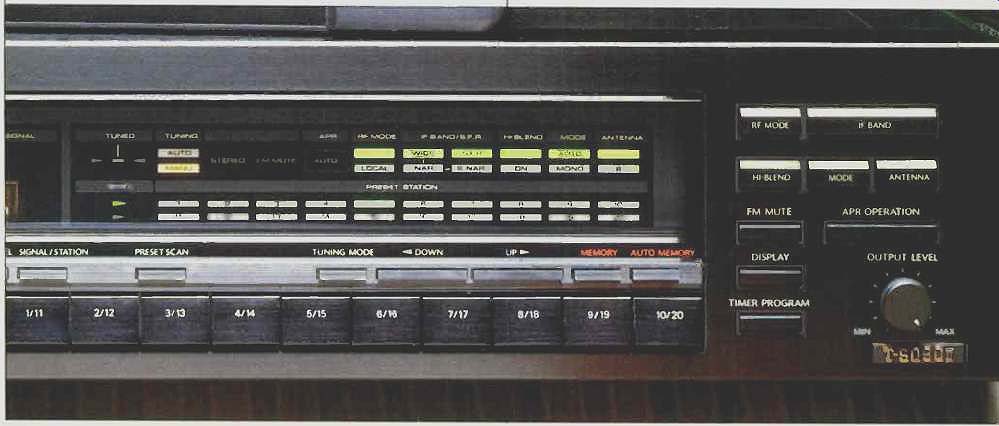
The remote supplied with the T-9090II allows complete control over most front-panel functions. It can even drive the motorized potentiometer that controls level at the variable output jacks. Preset stations can be sampled for 5 S each, and timer preset tuning (with an external timer) can be used to select preset stations in a predetermined order for unattended recording.
The T-9090II tunes in 50-kHz steps during automatic scanning, but manual adjustment is also possible, via the front panel, in 25-kHz steps. A multi-function fluorescent display shows station frequency, in MHz, to three decimal places. A linear scale shows relative r.f. input signal strength in 10-dB steps, and a numeric indicator also can show r.f. strength in dBf. The same numerical indicator can be set to show the signal threshold for scan tuning.
Control Layout
The on/off pushbutton is at the lower left of the front panel. To its right, along the lower edge of the panel, are a "Shift" button and 10 numbered buttons for setting or recalling up to 20 preset station frequencies (numbered 1 to 10 or, in combination with the "Shift" button, 11 to 20). Just above these are eight smaller keys for setting the scanning threshold (17, 27, or 37 dBf), displaying signal strength in dBf, initiating preset scanning, switching between manual and automatic modes, tuning up or down, storing memory presets, and calling up "Auto Memory" mode. The latter automatically finds stations which can be received satisfactorily.
It then stores them in order of ascending frequency, starting from the currently tuned frequency and whatever memory position you select.
On the right half of the display panel, a number of indicator lights show the various tuning modes selected manually or by the APR system, as well as muting status, stereo reception, and center-tuned status. Below them are 20 small, numbered indicator lights for the station presets.
Nine additional pushbuttons and one knob are at the right end of the panel. The five buttons in the top two rows select local or distant receptions, the i.f. bandwidth, high blend, stereo or mono, and antenna A or B. The remaining buttons control FM muting, restore APR operation after any of its settings have been overridden, indicate the next station to be selected during external-timer operation, and switch timer controlled station selection on and off. The small rotary knob controls the output level for the variable output jacks on the rear panel.
In addition to the two coaxial (75-ohm) antenna inputs and the fixed- and variable-level output jacks on the rear panel, there are two more jacks, labeled "V" and "H." These jacks can be connected to any oscilloscope's vertical and horizontal inputs for observing and minimizing multipath problems by antenna reorientation. For those who use flat, 300 ohm, twin-lead transmission lines from their antennas, Onkyo supplies 300/75-ohm matching transformers.
Measurements
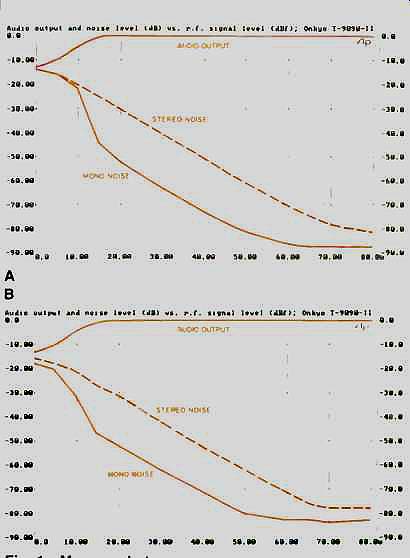
Fig. 1--Mono and stereo quieting characteristics, for wide (A) and narrow
(B) i.f. modes.
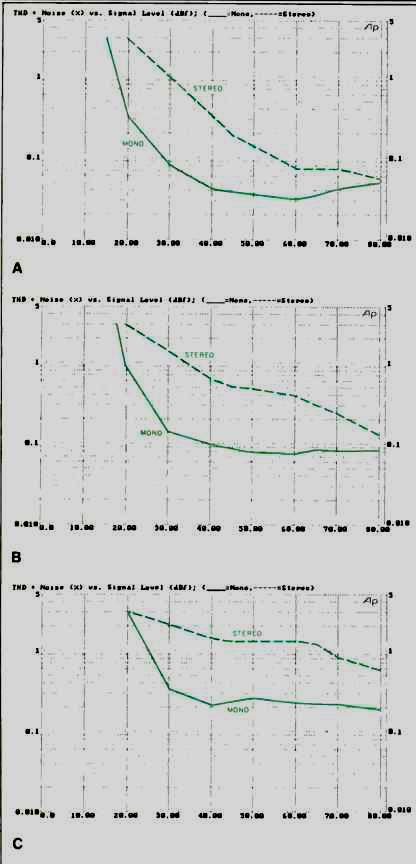
Fig. 2--THD + N vs. signal strength at 1 kHz for wide (A), narrow (B), and
super-narrow (C) i.f. modes.
In testing this tuner's quieting characteristics (Figs. 1A and 1B), I measured 12.0 dBf of mono usable sensitivity in the wide i.f. mode; this increased slightly, to 11.5 dBf, in the narrow mode. Stereo usable sensitivity was 20 dBf in the wide mode and 18 dBf in the narrow mode. Because no substantial difference in quieting characteristics occurred between the narrow and the super-narrow modes, no graph is shown for the latter. In mono, 50-dB quieting was achieved with 18 dBf of signal input in the wide i.f. mode; the same level of quieting was reached in the narrow mode with only 16 dBf of input signal. In stereo, the 50-dB quieting point was reached with a signal level of 39 dBf in the wide i.f. mode and 35 dBf in the narrow mode.
Best signal-to-noise ratio that I was able to read was 87 dB in mono (at 65 dBf) and 81 dB in stereo (at 80 dBf), using the wide i.f. mode. Outstanding though they are, these figures fall somewhat short of Onkyo's claims. I suspect that they are limited by the residual noise inherent in my FM generator. (I have never been able to measure better than 88 dB or so with this instrument.) Figures 2A, 2B, and 2C show THD + N versus signal strength. Lowest distortion for a 1-kHz modulating signal was, of course, obtained with the wide i.f. mode (Fig. 2A). Under these conditions, THD + N was only 0.035% in mono (for a 65-dBf signal) and 0.056% in stereo (for an 80-dBf signal). At 65 dBf, stereo THD measured 0.075%. The narrow mode yielded readings that were still below 0.1% in mono and just over 0.1% in stereo for strong, 80-dBf signals (Fig. 2B). Under conditions of extreme interference from adjacent channels, the super-narrow setting might be justified. This is true even though THD + N (for a 65-dBf signal) was more than 0.2% in mono and reached the 1% level in stereo in this mode (Fig. 2C). Plots of THD + N versus frequency, for a strong r.f., input signal, are shown in Fig. 3A (mono) and Fig. 3B (stereo). In each case, the bottom curve represents results obtained using the wide i.f. mode, the middle curve using the narrow mode, and the top curve using the super-narrow mode.
The audio generator output of my Audio Precision test gear can be equalized using a wide variety of curves. To measure frequency response of the Onkyo T-909011, I simply used a 75-1S pre-emphasis curve on the modulating audio signals. (This is the reciprocal of the de-emphasis characteristic required in FM tuners sold in the U.S.). In the response plot (Fig. 4), I have expanded the vertical scale to 2 dB per division. The response curve shows a superbly flat characteristic from 20 Hz to 10 kHz with a roll-off of a bit more than 1.0 dB at 15 kHz.
Separation verses frequency (Fig. 5) is plotted for all three i.f. bandwidths. At 1 kHz, separation ranged from over 50 dB to 45 dB, depending on the bandwidth setting. The solid curves represent the output of the modulated channel, and the dashed curves show the output of the unmodulated channel. Surprisingly, the middle dashed curve was obtained with the tuner set to the wide i.f. mode. The top dashed curve was plotted using the narrow mode, and the bottom dashed curve was made with the super-narrow mode. It's interesting to note that, at mid-frequencies, the best separation was obtained with the tuner set to where one would expect the worst separation! The effect of the super-narrow bandwidth is realized at higher frequencies, but even then, separation at 10 kHz remained nearly 40 dB in this mode! The super-narrow i.f. setting, while minimally affecting stereo separation, does have a rather marked effect on crosstalk and distortion, as shown in Figs. 6A and 6B. In these spectrum analyses, the sweep is linear, from 0 Hz to 50 kHz. In Fig. 6A (wide mode), you can see that the crosstalk products to the right of the main 5-kHz signal are much smaller in amplitude and more free of modulation noise than they are in Fig. 6B (super-narrow mode). I measured a capture ratio of 1.0 dB in the narrow mode and 1.5 dB in the wide mode. Image, i.f., and spurious rejection were all better than 100 dB. In the super-narrow mode, alternate-channel selectivity was an outstanding 95 dB and adjacent-channel selectivity was greater than 40 dB. In the wide mode, alternate-channel selectivity measured 38 dB. AM suppression was 62 dB, better than the manufacturer's claim.

Fig. 3--THD + N vs. modulating frequency for mono (A) and stereo (B).
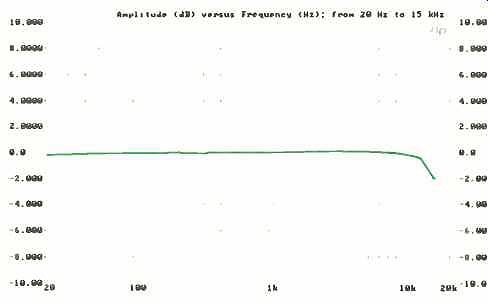
Fig. 4--Frequency response. Note vertical scale of 2 dB/div.
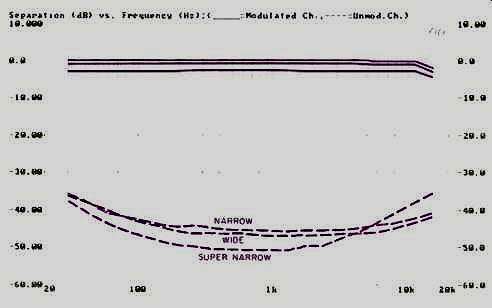
Fig. 5--FM frequency response (top curves) and separation vs. frequency
(bottom curves) for all three i.f. modes.
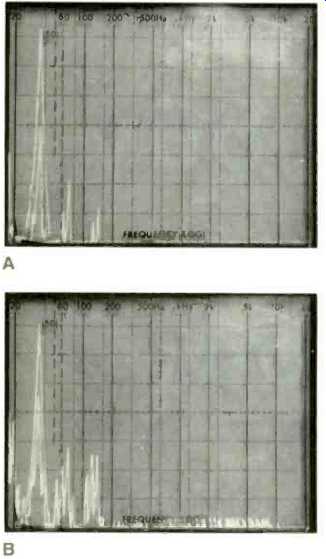
Fig. 6--Separation and crosstalk components for a 5-kHz modulating signal,
plus subcarrier and sideband components, for wide (A) and super-narrow (B)
i.f. modes.
Use and Listening Tests
I tried, repeatedly, to second-guess the APR system built into this "intelligent" unit, but with no success. I tuned to several stations of varying quality and manually tried to set up listening conditions that were contrary, in one way or another, to what I thought the APR system would have chosen. Each time I pressed the APR button, the system selected a set of operating conditions that yielded better results than those delivered by the conditions that I had chosen. In short, the APR system works--you can trust it completely.
To check out the two-antenna diversity reception capability in my metropolitan New York area, I hooked up a multi element outdoor antenna to one antenna input and an indoor dipole to the other. I was able to rotate the outdoor antenna to favor some distant Connecticut stations, while the indoor dipole was oriented toward the major, powerful stations in my area. Sure enough, when I set the tuner to automatic scanning, it switched back and forth between the two antennas exactly when it should have, and my total station count reached an astounding 58! There's no way I could have picked up this many usable signals from a single antenna, unless I rotated the antenna as each new signal was tuned in. Even at that, I probably would have missed some, since a single antenna might well have been rotated so far "off course" for certain signals that the scanning threshold would have overlooked them completely.
If you check out the T-9090II for yourself, don't be put off by its elaborate display area. True, there are an inordinately high number of indicators, but in this case, they are not there just for ornamentation. Each light really provides you with useful--perhaps even essential--information about the status and mode of the tuner's operation. It you are as much of an FM fan as I am, and if you are blessed with a couple of FM stations that really care about the signals they transmit, this is definitely a tuner worth considering.
On a practical level, I am amazed to see that the price of the T-9090II, for all its enhanced features and higher performance, is not much more than that of the earlier Model T-9090-and this in the face of the steadily rising value of the Japanese yen against the dollar. Obviously, Onkyo's talents apply not only to FM design engineering, but to production efficiency as well.
---Leonard Feldman
(Source: Audio magazine, Jul. 1988)
Also see:
Onkyo Model A-7 Integrated Amplifier (Jan. 1978)
Onkyo DX-G10 Compact Disc Player (Mar. 1989)
Optonica ST-3636 AM/FM Stereo Tuner (Dec. 1978)
= = = =